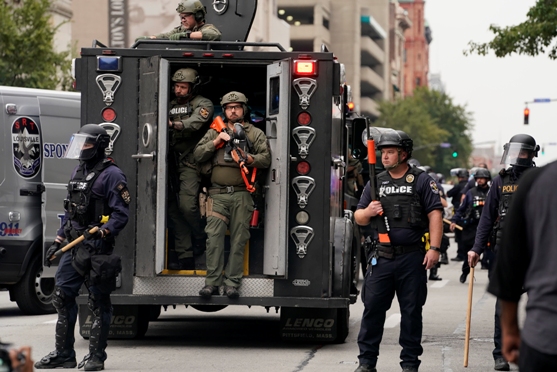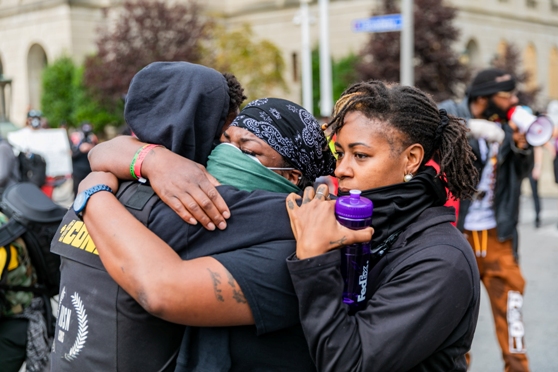Taylor grand jury indicts an officer and clears two
By Rukmini Callimachi, Nicholas Bogel Burroughs, John Eligon and Will Wright
LOUISVILLE, Ky. — A grand jury weighing evidence in one of the country’s most contentious police shootings indicted a former Louisville police detective on charges of reckless endangerment Wednesday (23) for his role in the raid on the home of Breonna Taylor, but the two officers who shot Taylor six times faced no charges.
Protesters poured into the streets in Louisville after the announcement, and at least two police officers were shot shortly before a 9:00 p.m. curfew. There were also demonstrations in New York, Chicago, Milwaukee and smaller cities around the country.
The demonstrators called for all three officers, who are white, to be held to account for Taylor’s death in March. The officers had fired a total of 32 shots after they stormed her apartment with a warrant.
Prosecutors found that the two officers who shot Taylor, who was Black, were justified in their use of force because they had identified themselves as officers and had then come under fire from her boyfriend, who said he thought it was intruders forcing their way inside. The charges against former Detective Brett Hankison were for firing recklessly into a neighbour’s apartment.
Taylor’s death, which came months before George Floyd was killed by the Minneapolis police, became a rallying cry for racial justice protesters nationwide. On Wednesday afternoon, hundreds of demonstrators chanted Breonna Taylor’s name between sobs and scowls as they wound their way through the streets of Louisville. They carried signs that said ‘abolish police’ and ‘Black lives matter’. Dozens of cars followed, honking their horns.
For more than two hours, the police followed in silver cruisers without intervening. But eventually a line of officers in riot gear confronted protesters, released chemical agents and arrested several people in the crowd.
At a news conference Wednesday in Frankfort, Kentucky’s attorney general, Daniel Cameron, walked through the grand jury’s decision in detail in an effort to defuse the rage.
“The decision before my office is not to decide if the loss of Breonna Taylor’s life was a tragedy — the answer to that question is unequivocally yes,” he said.
Cameron, a Republican, acknowledged that not everyone would be satisfied with the charges and said that as a Black man, he understood the pain that was brought about by Taylor’s death.
“Justice is not often easy and does not fit the mould of public opinion. And it does not conform to shifting standards,” Cameron said.
The grand jury decision to indict Hankison came after more than 100 days of protests on the streets of Louisville and after a months-long investigation into the death of Taylor, a 26-year-old emergency room technician who was shot in the hallway of her apartment by officers executing a search warrant as part of a drug investigation.
Grand jurors indicted Hankison, a detective at the time, on three counts of “wanton endangerment”, saying he had imperilled the lives of three of Taylor’s neighbours by firing bullets that reached their apartment.
Hankison fired through a door and window of Taylor’s apartment building that were covered with blinds, violating a department policy that requires officers to have a line of sight. At least some of his rounds reached the apartment directly behind Taylor’s, where a pregnant woman, her husband and their 5-year-old child were asleep. The rounds shattered the family’s glass door but did not harm anyone.
Hankison is the only one of the three officers who fired their weapons who was dismissed from the force, with a termination letter stating that he showed “an extreme indifference to the value of human life”.
Earlier Wednesday in downtown Louisville, crowds who had gathered to listen as the indictment was read aloud cried out in fury and grief.
After the announcement, protesters shrieked in disgust. Shouts of “That’s it?” rose from the crowd. One person called for the city to be burned down. Several people broke down in sobs.
Taylor’s mother, who had sued the city of Louisville for wrongful death in April, received a $12 million settlement last week. But Ben Crump, a lawyer for the family, wrote on Twitter that the lack of additional charges was “outrageous and offensive”.
Many legal experts had predicted that indictments would be unlikely, given that a state statute in Kentucky allowed citizens to use lethal force in self-defence and that it was Taylor’s boyfriend who had fired first.
“As an African American, as someone who has been victim of police misconduct myself, getting pulled over and profiled, I know how people feel,” said John W. Stewart, a former assistant attorney general in Kentucky. “I have been there, but I have also been a prosecutor, and emotions cannot play a part here.”
During the raid, two officers, Sgt. Jonathan Mattingly and Detective Myles Cosgrove, returned fire after Taylor’s boyfriend, Kenneth Walker, fired one shot that struck Mattingly in the leg, Cameron said. Walker’s bullet pierced Mattingly’s femoral artery, and the other officers scrambled to drag him out of the apartment and apply a tourniquet to his leg.
The officers who broke down Taylor’s door shortly after midnight on March 13 had come with a search warrant, signed by a local magistrate. They had court approval for a “no-knock” warrant, which Louisville has since banned, but the orders were changed before the raid, requiring them to knock first and announce themselves as the police.
Walker has said that he and Taylor did not know who was at her door. Only one neighbour, out of nearly a dozen interviewed by The New York Times, reported hearing the officers shout “police” before entering.
The warrant for Taylor’s apartment was one of five issued in a case involving her ex-boyfriend Jamarcus Glover, who is accused of running a drug trafficking syndicate. At the other addresses that were searched, officers found a table covered in drugs packaged for sale, including a plastic sachet containing cocaine and fentanyl, police logs and a laboratory report show.
The surveillance leading police officers to Taylor’s home included a GPS tracker showing repeated trips by Glover to her home; photographs of him emerging from her apartment with a package in his hands; footage showing her in a car with Glover arriving at one of the trap houses he operated; and his use of her address on bank records and other documents. The FBI has opened an investigation into whether the inclusion of her name and address on the warrant violated her civil rights, as her family’s lawyers have claimed.
The announcement Wednesday revealed several new details in the case. Investigators at an FBI laboratory reviewed the ballistics evidence and concluded that the shot that killed Taylor was fired by Cosgrove. A total of 32 shots were fired by the police: 16 by Cosgrove, 10 by Hankison and six by Mattingly. The attorney general said none of Hankison’s rounds struck Taylor.

-New York Times


